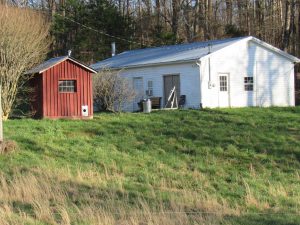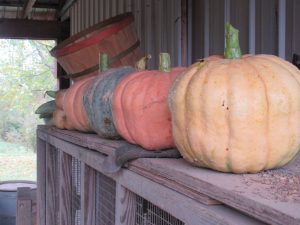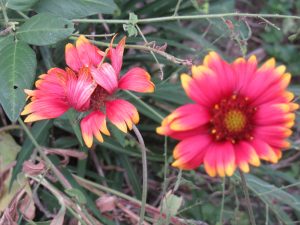The first gate leading into the large wooded pig paddock hangs next to a building we call “the other house.” One of the few structures on our farm when we bought this land in 1999, it is the size and configuration of a three-bay garage, with two of the three “bays” fully enclosed as rooms. The previous owner had built the structure, then felt cooped up on 50 acres in East Tennessee and headed to Montana before moving forward on a more permanent residence. We finished out two of the bays for a living space, where we stayed for three years while we expanded the farm’s infrastructure and then built a home of our own.

The “other house”
The gate next to the building leads into a chute with two other gates, all of which facilitates the loading of pigs. It is through this chute system that I pass on this Saturday afternoon with no aim but a ramble with a cigar. Ahead some 30 feet is a pig trough, where fat, grain-fed squirrels cluster around the remains of a porcine feast. The massive barrows are deeper in the woods, taking a postprandial siesta. At the clang of the gate the rodents are off, struggling to get their bulk up an oak tree and out of sight.
This wooded paddock is markedly different than the open woods beyond. With a few shoots of grass here and there, it is more rocky moonscape than lush landscape. Pigs will do that to the land. In the past 15 years they have gradually thinned out the brush and the smaller trees in this area, leaving enough debris on the ground to please a tornado. I cross the one-acre paddock and enter into the 50×200-foot enclosure on the far side, where the remains of a 12-port wooden hog feeder lie unused and in disrepair. A skulking rat scurries past my periphery but is gone before I can turn my head. I pull out my little notebook and jot down, “Clean up feeder” — time to get our trash out of these woods.
In the middle of this smaller area stands a woebegone maple, three feet in diameter. The base is rotted and has been hollowed out by the hogs. Some day, maybe sooner than later, a pig in search of grubs will be in for a surprise, I think.
Across the fence is a clean five-acre field belonging to one of our closest neighbors, a young couple. The man and I agreed a few weeks back, while cutting up a large fallen oak, that I would harvest the field this year for hay for our farm. The area has not been pastured seriously in all the time we have been on this land, and I hope for a good yield. That cutting plus that from our lower seven acres should pack the haybarns from floor to rafters.
The flight of half a dozen whitetails through the brush turns my gaze. While I have pondered over my future forage wealth, the deer, who heretofore have been watchful, finally feel it prudent to move on, and at speed. White flags flipping through the undergrowth, quick sprints and then a pause, a few more steps, an effortless sail over barbed wire at the far end of these small woods, and they are gone.
Walking back, making some more notes of possible projects, I stop and scratch the sleeping hogs. They have three months left on this earth before providing an excellent return to us and our customers in bacon and pork chops. Just over the fence from where I now stand is our 12-acre hill pasture. I spent this morning subdividing it into small grazing paddocks separated by electric fencing. While we don’t rotate our sheep as often as some, we do more than most. Every two weeks they move on to a new section of green grass, at least in seasons of fast-growing forage. I’ll turn them out of their current pasture onto the fresh growth in the morning. Sheep do an effective job, much like pigs, of keeping the land cleared. Perhaps too effective: left too long or too many and our hills may begin to resemble those of Greece. So, it’s critical to keep them on the move, again and again.
I walk back to the house and put on our afternoon pot of coffee. Time to catch up with Cindy.
…………………………………………………………………………………………
Reading this weekend: Galloway, life in a vanishing landscape (P. Laurie). Both a natural history of the Scottish Lowlands and a farming memoir, it has echoes of the writings of James Rebanks. It is well-written, and I hope to finish it by this evening.


